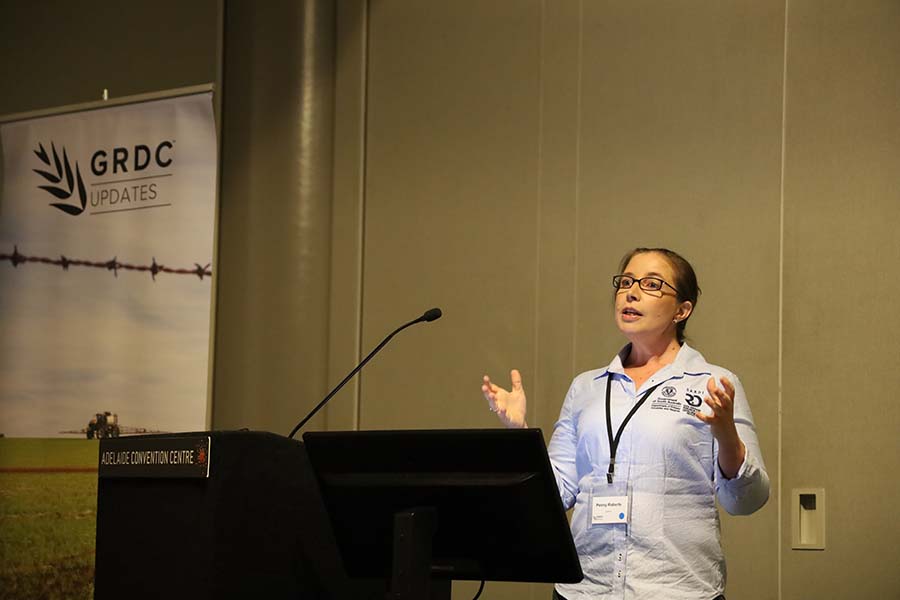The challenge
Rotations that include break crops, such as lentils, as frequently as cereals are known to increase farm profitability in South Australia. They are referred to as high break crop intensity (HBCI) rotations.
The introduction of herbicide-tolerant break crop options has helped drive uptake of HBCI rotations and reduced the costs of weed control. Included are XT lentils, Clearfield® canola, TT canola and PBA Bendoc. This shift, however, has raised issues around the development of herbicide resistance.
For example, HBCI rotations have increased reliance on Group 1 chemistry (fops and dims) to control annual ryegrass, leading to the development of resistance to this herbicide group. There is an increase in the uptake of alternative chemistry groups, such as 15 and 3 herbicides for control of dim-resistant annual ryegrass in HBCI farming systems. This has increased the risk of herbicide resistance developing to these newer pre-emergent chemistries.
Additionally, the herbicide-tolerant crops (which provide improved broadleaf weed control options) have resulted in an over-reliance on a few modes of action, especially Group 2 herbicides. This over-reliance and the recurrent use of imidazolinone (IMI) herbicides for broadleaf weed control have increased the risk of selective pressure on the weed flora and the development of resistant weeds.
The response
SARDI researcher Dr Penny Roberts. Photo: GRDC
To ensure a profitable and sustainable future for HBCI rotations, GRDC invested in the development of weed management information packages that are specific for these farming systems. These management packages will control annual ryegrass and broadleaf weeds in HBCI rotations.
The packages were developed by the South Australian Research and Development Institute (SARDI) and emerged from long-term monitoring of paddocks under HBCI rotations combined with targeted research trials during 2019-20 in the Mid-North and Yorke Peninsula regions. The project was led by Dr Penny Roberts.
The packages include:
- effective weed management strategies for dim-resistant annual ryegrass;
- effective weed management strategies for major broadleaf weeds;
- herbicide recommendations for sustainable use of IMI chemistries in HBCI systems dominated by Group 2-tolerant break crops; and
- an understanding of the impacts possible from integrated weed management practices, including crop competition, plant population, sowing methods and the incorporation of new herbicide-tolerant pulse crops on weed control and crop performance.
The research also highlighted the importance of adopting integrated weed management strategies and rotating herbicides with different modes of action, and emphasised the urgent need to look across the whole system and not just focus on weed control in individual crops. There is also a need to control seed-set and reduce the seedbank.
The impact
Overall, the weed management packages were found to hold the key to the sustainability of HBCI rotations. Developing the packages produced an internal return rate of 138 per cent for the full program, with a benefit:cost ratio of 1.60.
After 30 years, the full program would cost $5 million including partner in-kind. The present value of benefits for the full program was $8 million.
The analysis also quantified a series of on-farm economic benefits:
- Adopting herbicide-tolerant break crops and improved herbicide practices results in a yield advantage of up to 32 to 43 per cent over standard grower practices.
- The packages result in a yield advantage of up to 44 per cent in Group 2-tolerant faba beans.
- Avoiding off-label use of sulfonylureas for broadleaf weed control (and instead using registered IMI herbicides) can prevent yield losses of up to 13 per cent and 27 per cent in Group 2-tolerant lentils and faba beans, respectively.
These benefits can then be protected by rotating IMI herbicides with other modes of action to reduce the selection pressure on broadleaf weeds, especially for Group 2 herbicides.
The adoption of improved integrated weed management practices will additionally:
- slowly run down the soil weed seedbank and the spread of herbicide-resistant weeds;
- reduce weed control costs in the subsequent crops in the rotation; and
- maximise crop performance, thereby reducing production losses.
Effective control also reduces pulse grain contamination with weed seeds. These costs can be as high as $25 per tonne of grain due to cleaning costs and price dockages.
Broadleaf weed seeds including vetch/tares, bedstraw and bifora present the greatest challenge as they are difficult to separate from pulse grains, especially lentils, due to the similar seed size.
With a whole-farm system approach, project leader Dr Roberts says industry can sustainably continue to achieve break crop benefits in terms of:
- nitrogen fixation from pulses;
- a subsequent yield increase in the following rotational crops;
- disease breaks for cereal crops; and
- monetary returns (depending on market prices).
More information: Delivering impact case studies.


























































